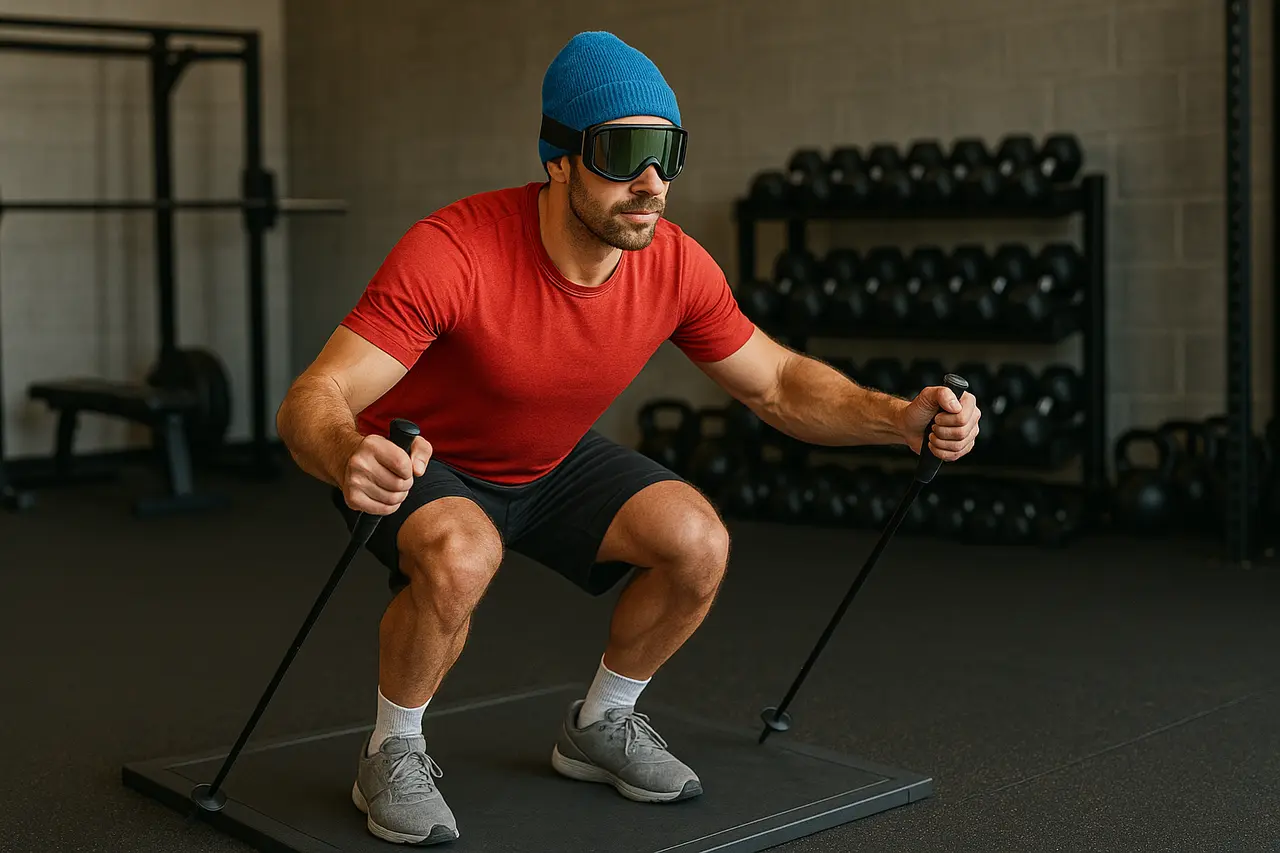Planning a ski trip is exciting, but ensuring you are physically prepared can make all the difference in your experience. This guide will explore how incorporating fitness and training into your routine can enhance your enjoyment and safety on the slopes.
Understanding the Physical Demands of Skiing
Skiing is a dynamic sport that requires strength, endurance, and balance. It involves not just your legs but also your core and upper body. Understanding these demands is the first step in tailoring your fitness routine. Each run down the slope challenges these muscle groups differently, requiring adaptability and stamina. For instance, when you make sharp turns or navigate uneven terrain, your core stability is tested, providing crucial support to your spine and helping maintain balance. A strong core is essential for efficient skiing, as it allows smoother transitions and improved control over your movements. This core activation is complemented by leg strength, which provides the power necessary to push off the ground, absorb shocks, and maneuver with precision.
Balance plays a significant role in skiing, often underestimated by new and even intermediate skiers. It’s not just about staying upright; it’s about maintaining control and fluidity. Adjusting to the shifting conditions of the slope, such as icy patches or fresh powder, requires you to be constantly aware and responsive. Balancing exercises, such as single-leg stands or using a balance board, can significantly improve your performance on the slopes. In addition to physical strength, mental acuity is vital. Skiing demands quick decision-making and the ability to anticipate movements, making it as much a mental challenge as a physical one.
The environmental conditions also add a layer of challenge. Cold temperatures, high altitudes, and the physical demands of skiing increase the workload on your cardiovascular system. As your body works harder to maintain warmth and deliver oxygen to muscles, cardiovascular fitness becomes crucial. Without adequate endurance, fatigue can set in rapidly, leading to decreased performance and increased risk of injury. By conditioning your heart and lungs, you’ll be able to enjoy longer days on the slopes without wearing out too quickly. Furthermore, cardiovascular health supports overall stamina, allowing you to recover more quickly between runs and enjoy the après-ski activities too.
Benefits of Pre-Trip Fitness Training
Pre-trip fitness training is your secret weapon for maximizing ski season enjoyment. By improving your cardiovascular endurance, you build the foundation for stamina needed for those long days on the mountain. Regular aerobic exercise, such as running, cycling, or swimming, boosts your endurance levels, enabling you to sustain energy over extended periods without fatigue setting in too quickly. Increased cardiovascular health also contributes to faster recovery times, allowing you to ski day after day with minimal downtime.
Building muscle strength is another cornerstone of effective training for skiing. Exercises focusing on lower body strength—like squats, lunges, and calf raises—prepare your muscles for the specific demands of skiing. Enhanced muscle power translates to better control on declines, enabling quicker and more precise movements. Moreover, you’ll be less prone to common skiing injuries such as knee strains or ankle sprains, as well-conditioned muscles provide better joint support. Incorporating resistance training can significantly bolster your muscle capabilities, offering protection and durability against the rigors of the slopes.
In addition to physical performance, pre-trip training offers psychological benefits. Knowing you’re physically prepared boosts confidence, reducing anxiety and improving overall enjoyment. When you’re confident in your body’s abilities, you can focus more on the joy of skiing rather than worrying about potential mishaps. Fitness training also enhances mood through the release of endorphins, providing a mental boost that can make your ski trips more rewarding and memorable.
Essential Exercises for Ski Preparations
To get ready for the slopes, incorporating specific exercises into your routine is crucial. Squats are a staple, targeting your quads, hamstrings, and glutes—all essential for powering your turns and absorbing the impact of moguls. For an added challenge, try squat variations like jump squats or goblet squats, which further enhance explosive power and stability. Lunges are equally important, strengthening the legs while improving balance and coordination. Single-leg lunges, in particular, mimic the alternating pressures experienced when shifting weight from ski to ski, offering excellent functional training.
Core exercises cannot be overstated. A stable core is pivotal in maintaining balance and executing smooth, controlled skiing movements. Planks and their variations, such as side planks and plank rotations, are great for core fortification. Engage in rotational core exercises, like Russian twists, to replicate the twisting motions you’ll perform on the slopes, adding an extra layer of preparedness. Flexibility exercises, like yoga or pilates, complement strength training by improving range of motion and reducing stiffness—key factors in preventing injuries and allowing for unrestricted movements.
For those looking to refine their balance and coordination, integrating balance exercises is a must. Stand on a balance board or use a stability ball to challenge your equilibrium. These practices simulate real-life skiing scenarios, enhancing proprioception—the body’s ability to sense and react to changes in position. Additionally, incorporating plyometric exercises, such as box jumps or lateral hops, can increase your agility, allowing you to swiftly adjust to the demands of varying slope conditions. Each of these exercises contributes uniquely to your overall preparedness, ensuring you can tackle any skiing challenge with confidence and agility.
Creating a Balanced Training Schedule
A well-rounded training schedule is essential for a fully prepared ski trip. Begin by assessing your current fitness level and setting realistic, incremental goals. Your training regimen should blend strength training, cardiovascular workouts, and flexibility exercises to cover all aspects of skiing physicality. Aim for at least three strength workouts a week, focusing on major muscle groups used in skiing. Include two to three cardio sessions, mixing longer, steady-state cardio with interval training to build endurance and explosive capacity.
Flexibility sessions, such as yoga or pilates, can be integrated into your schedule once or twice a week. These exercises not only improve flexibility but also promote mental relaxation, reducing pre-ski trip stress. Remember to balance high-intensity training with sufficient rest, allowing your muscles time to recover and adapt. Listening to your body and adjusting the intensity of your workouts helps prevent overtraining, which could lead to injuries. Consistency is key. Even short, targeted workouts can yield significant improvements over time if done regularly.
To personalize your training plan, consider consulting a fitness professional familiar with skiing-centric training regimens. They can tailor workouts to your specific strengths and weaknesses, maximizing efficiency. Tracking your progress, whether through a fitness app or a simple journal, can provide motivation and insight into your improvements. By maintaining variety and focus in your training, you’ll build a comprehensive fitness foundation that enhances your skiing adventures.
The Importance of Recovery and Injury Prevention
Recovery is a critical element of any fitness program, and its importance can’t be overstated when preparing for skiing. Adequate recovery helps in muscle repair and reduces the risk of injury, ensuring you remain at peak performance. Incorporating rest days into your training, where you allow your muscles to recuperate, is as vital as the workouts themselves. Active recovery, like light stretching or walking, can keep you limber without overexerting tired muscles.
Injury prevention goes hand in hand with effective recovery strategies. Implementing a well-regimented warm-up before workouts and skiing sessions is crucial. Dynamic stretches and light cardio help prepare your muscles and joints for activity, reducing the risk of strains and sprains. Cooling down after skiing or workouts, followed by static stretching, aids in alleviating muscle soreness and reducing stiffness. Nutrition also plays a pivotal role in recovery and injury prevention. A diet rich in proteins, healthy fats, and carbohydrates supports muscle repair, fueling your body adequately for demanding skiing activities.
Finally, understanding the importance of listening to your body is crucial. Paying attention to signs of fatigue or discomfort can help prevent overuse injuries. Seeking advice from a healthcare professional if persistent pain arises is essential, as this could indicate an underlying issue rather than simple post-exercise soreness. Embracing a comprehensive recovery routine enhances not only your athletic endeavors but also contributes to overall health and well-being, making your ski trips more enjoyable and injury-free.
Embrace Fitness for a Successful Ski Trip
By dedicating time to fitness and training before your ski trip, you’ll be setting yourself up for a fun, safe, and fulfilling experience. Remember, preparation is key, and the effort you put in now will pay off when you’re enjoying the snow-covered mountains.



Share:
Stay Organized on the Go: Top Car Gadgets for Ski Lovers
Discovering Hidden Treasures: The Best Underrated Ski Resorts